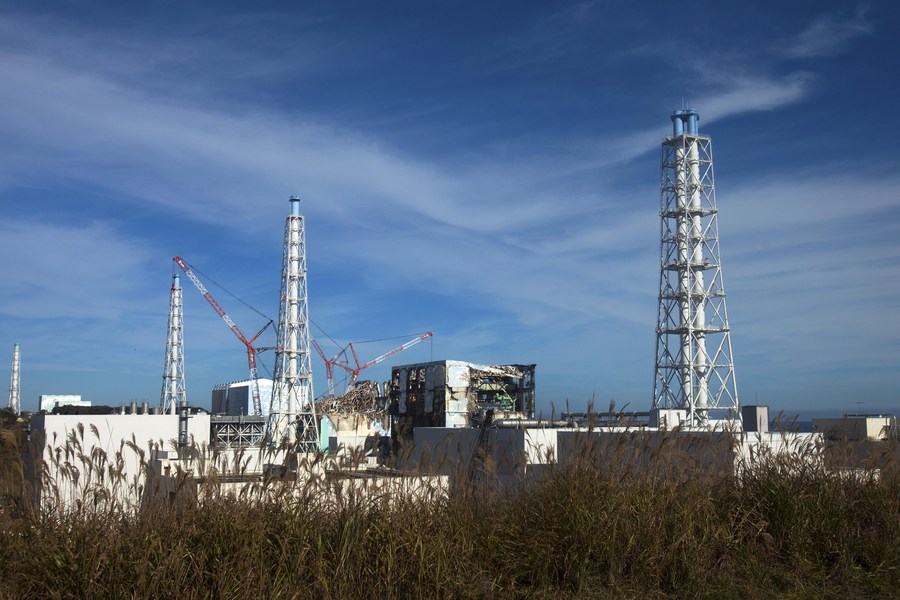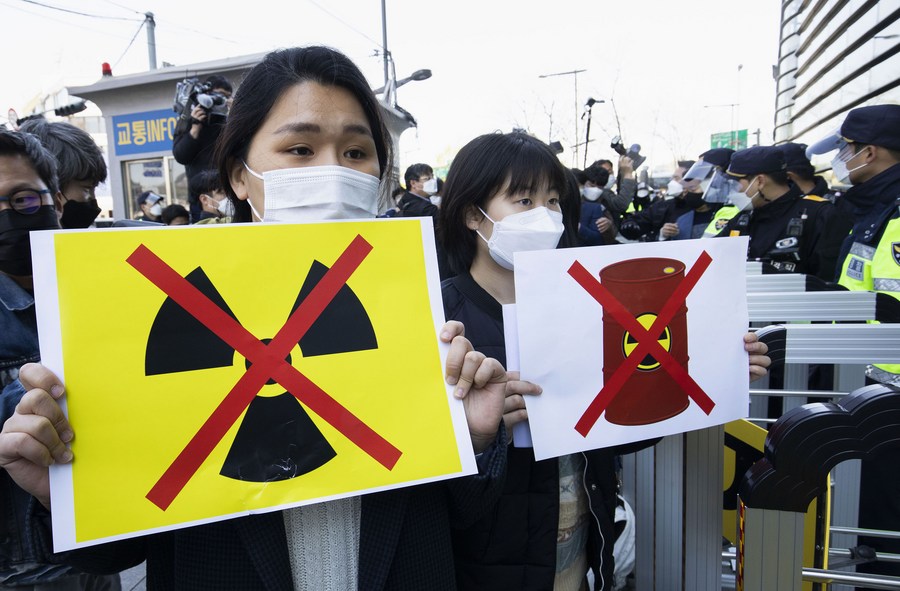
People rally to protest against the Japanese government's decision to discharge contaminated radioactive wastewater in Fukushima Prefecture into the sea, in Tokyo, capital of Japan, April 13, 2021. (Xinhua/Du Xiaoyi)
The Japanese government's drive to push through a long-term plan to release wastewater into the Pacific Ocean starting in the spring of 2023, despite domestic and international opposition, is extremely selfish, analysts say.
TOKYO, Aug. 11 (Xinhua) -- Japan's Tokyo Electric Power Company Holdings Inc. (TEPCO) has recently started construction of facilities that will discharge radioactive wastewater from the crippled Fukushima Daiichi nuclear power plant into the sea, taking another step in its plan to release nuclear-contaminated water.
The Japanese government's drive to push through a long-term plan to release wastewater into the Pacific Ocean starting in the spring of 2023, despite domestic and international opposition, is extremely selfish, analysts say.
SELFISHNESS
Struck by a magnitude-9.0 earthquake and ensuing tsunami that hit Japan's northeast on March 11, 2011, the No. 1-3 reactors at the Fukushima Daiichi nuclear plant suffered core meltdowns, resulting in a level-7 nuclear accident, the highest on the International Nuclear and Radiological Event Scale.
The plant has been generating a massive amount of radiation-tainted water since the accident happened as it needs water to cool the reactors. With groundwater and rainwater also flowing in, about 1.3 million tons of contaminated water are now stored at the nuclear plant and are still increasing at a rate of 140 tons a day.

File photo taken on Nov. 12, 2011 shows the exterior of Fukushima Daiichi nuclear plant in Fukushima Prefecture, Japan. (Xinhua)
TEPCO claimed that the water storage tank's current storage capacity of 1.37 million tons will run out this autumn and the plant has no more space for new water storage tanks to be constructed, so it has to release the contaminated water into the sea after filtering, purifying and diluting it.
In response to TEPCO's claims, Japanese environmental groups pointed out that much of the land near the plant has been left idle due to nuclear leakage and could be used to construct additional water storage tanks.
However, the Japanese government and TEPCO rejected the idea, citing the need for a large amount of time for communication and coordination as well as a lot more work.
Environmentalists say it is not that the option is infeasible, it is because the Japanese government and TEPCO do not want to do it, as they put their own interests first.
A panel of experts organized by Japan's Ministry of Economy, Trade and Industry had proposed five options when considering how to deal with the contaminated water.
Among them, the Japanese government said the options of discharging the water into the sea and vapor release were two "most practical solutions" and it finally chose the former one, which "takes the shortest time and costs the least," passing on the risk to the whole world.
BROKEN CREDIT
Contaminated water generated at TEPCO's Fukushima Daiichi nuclear power plant contains tritium, cesium, strontium and other radioactive materials. The Japanese government and TEPCO said they would use the Advanced Liquid Processing System (ALPS), a multi-nuclide removal equipment, to reduce the concentrations of 62 types of radioactive substances, with the exception of tritium, which is hard to remove by purification and will remain in the treated water.
TEPCO believes that tritium normally remains in the wastewater at ordinary nuclear power stations, therefore it is safe to discharge tritium-contaminated water.
Experts say TEPCO is trying to confuse the concept of the wastewater that meets international standards during normal operation of nuclear power plants with that of the complex nuclear-contaminated water produced after the core meltdowns at the wrecked Fukushima power plant.
The actual results of ALPS are not as ideal as TEPCO claims. Japanese media have found that in addition to tritium, there are a variety of radioactive substances in the Fukushima nuclear wastewater that exceed the standard. TEPCO has also admitted that about 70 percent of the water treated by ALPS contains radionuclides other than tritium at the concentration which exceeds legally required standards and requires filtration again.
Also the reliability of ALPS itself is questionable. According to a report by Japan's Asahi Shimbun in September 2021, 24 of the 25 filters used by ALPS to absorb radioactive substances were damaged, and the damage occurred two years ago, but TEPCO did not deal with it in time.

A poster to boycott Japanese products is seen in a supermarket to protest against Japan's decision to dump radioactive wastewater from the crippled Fukushima Daiichi nuclear power plant into the Pacific Ocean, in Seoul, South Korea, April 14, 2021. (Photo by Xu Ruxi/Xinhua)
The Korean Federation for Environmental Movements, a South Korean civic environmental organization, said that TEPCO claimed to have the ability to reduce the concentration of 62 radioactive substances excluding tritium before the discharge of the contaminated water, but this is by no means the truth. The organization warned that it is hard to clean the sea water once it is polluted.
From the cover-up of the meltdown at the beginning of the Fukushima disaster to the bowing and apologizing for underreporting for more than a decade, TEPCO has left so many stains on its credibility that its nuclear credit has long since gone busted.
OPPOSITION FROM ALL SIDES
The willful push by the Japanese government and TEPCO to release wastewater into the sea has triggered strong opposition from both within Japan and its neighboring countries. Last Wednesday, a local civic group organized a protest outside the government house of Fukushima Prefecture to show their opposition to the plan.
After TEPCO announced last Thursday the start of the construction of facilities for releasing radioactive wastewater into the sea, a Japanese environmental organization issued a statement on the same day, pointing out that the Japanese government and TEPCO had made written commitments on the matter saying "without the understanding of relevant personnel, no actions will be taken." However, the government still decided in April last year to release the nuclear-contaminated water into the sea without seeking advice from relevant parties to make it a fait accompli.

People protest against Japan's decision to dump radioactive wastewater from the crippled Fukushima Daiichi nuclear power plant into the Pacific Ocean outside Japanese embassy in Seoul, South Korea, April 14, 2021. (Photo by Xu Ruxi/Xinhua)
On July 22, the Nuclear Regulation Authority of Japan officially endorsed TEPCO's nuclear-contaminated water discharge plan.
Responding to this, Masanobu Sakamoto, president of the National Fisheries Cooperative Federation of Japan, said the plan has not gained the understanding of the public and the fishery industry and that the federation's firm opposition to the discharge had not changed at all.
Greenpeace Seoul Office said that the danger of discharging nuclear-contaminated water into the sea is obvious. The Japanese government's decision to discharge the contaminated water into the sea when there are alternatives such as long-term storage violates the precautionary principle recognized by the international community. ■












